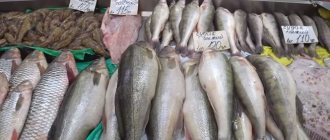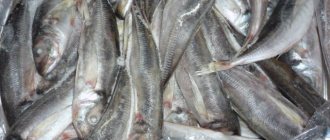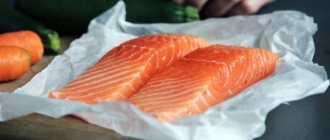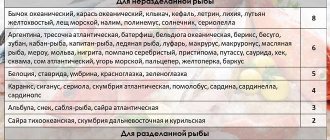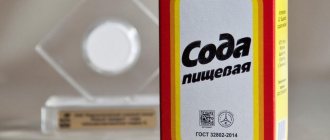Equipment to order
We manufacture and supply equipment to order in Russia, Ukraine, Belarus, Kazakhstan, Moldova, Azerbaijan, Georgia, Latvia, Finland, Greece, Poland. Phones: +38; +38 (067) 531-64-92; +38 E-mail: Order
Freezing fish, like any other product, must be carried out in compliance with all sanitary standards and rules, and special freezing equipment is used. However, there are features that significantly distinguish the process of freezing fish. Their soft tissues contain a large amount of liquid, which can extend shelf life if properly frozen.
Super-freezing technology allows fish and seafood to retain the properties of fresh products
Super freezing is a technology that guarantees absolute freshness, original density of meat and natural taste of fish. Products frozen using this technology, which are also stored at a temperature of minus 60 degrees Celsius, have all the characteristics of fresh products. Eurofish reports this. This technology was developed in Asia. Even 20 years ago, the idea of freezing and storing high-quality species such as tuna at very low temperatures (minus 60 degrees) appeared in Japan. The creation of such technology was prompted by increased distances for transporting products. Conventional blast freezing could no longer maintain the quality of tuna. This was especially true for the then popular high-quality cuts of trevally, such as chutoro - the belly area of tuna or otoro (with a lot of fat streaks), which quickly lost quality when simply frozen.
These types are considered an expensive product. Minus 30 degrees in the freezer was not enough to quickly reduce the internal temperature of fish weighing 200 kilograms or more. And a storage temperature of minus 18 degrees cannot completely block all chemical and biological processes occurring inside the fish. Only at a temperature of minus 62 degrees Celsius do almost all physiological processes inside the fish stop. Therefore, the shelf life of super-frozen fish is twice as long as the shelf life of ordinary frozen fish. When super-frozen, fish can be stored for 2 years without losing its quality. It is also worth adding that the original freshness of the raw materials and other characteristics of the product are preserved like no other preservation method.
However, when using a super freezer, it takes 1.5 days to reduce the internal temperature of 200 kilograms of tuna to minus 60 degrees. The technology used is complex and requires special skills. We must not forget that such temperatures can lead to serious burns and blisters on the skin. Typically, tuna are killed almost immediately after being caught, the gills are removed and the blood is bled out. After this, specialists quickly cut the fish into back fillets, pieces, steaks and other parts that can be frozen more quickly. They are placed in a container of dry ice (about minus 80 degrees Celsius) and surrounded by liquid nitrogen (about -170 degrees Celsius). This reduces the temperature in the tissues so quickly that ice crystals cannot form in the cells and destroy the membranes. This in turn prevents the loss of fluid in cells and tissues and maintains a physiological state very close to that of a fresh living product. This process occurs in less than 4 hours after catching, so rigor mortis does not occur.
Guaranteed freshness and quality
In Western countries, processors began to use super-freezing technology only a few years ago. This has created a real boom in the production of sushi and sashimi, which require raw fish and seafood of maximum freshness. This is not an easy task since the raw materials usually come from all over the world.
In Europe and North America, authorities require or recommend that all fish products intended for raw consumption must be frozen for a specified period of time to kill parasites.
Insiders estimate that more than half of the raw materials for sushi and sashimi that consumers consider fresh already come in frozen form. Even in Japan, the birthplace of sushi, 80% of tuna is supplied to sushi bars in frozen form. However, in Japan, all fish is super-frozen and is of high quality, which is no different from the quality of fresh products. Franchise companies such as AFC Sushi (with over 1,800 stores throughout the United States) process exclusively ice cream raw materials. These are mainly conventionally frozen raw materials, but the company has already begun processing super-frozen fish products.
Supplies and prices
The advantages of super-freezing technology are not only guarantees of quality and safety from parasites. Unlike fresh fish, whose supply can fluctuate significantly depending on the season, frozen products are always available. In addition, frozen fish is usually much cheaper than fresh fish. For example, frozen tuna costs $8-15 per kilogram in wholesale stores, depending on the type and cut, and the price of fresh fish can be more than twice as high. The fluctuations in quality that are inevitable during spawning and migration are also more easily overcome by stocking frozen fish.
Superfrozen tuna also has another advantage: since all chemical and biological processes in meat cells stop at a temperature of minus 60 degrees Celsius, there is also no oxidation of hemoglobin and myoglobin in the meat. This helps maintain the brownish color of the meat. In other words, super-frozen tuna products retain their original color throughout the entire storage period and, after defrosting, the meat looks fresh. The same effect can only be achieved by using the prohibited method of treating fish with carbon monoxide or tasteless smoke.
With the exception of the USA, where tasteless smoke is still widely used, the use of this method is either prohibited or restricted in almost all developed countries such as Japan, Canada, and the EU.
Logistics requirements
Fish markets around the world are currently undergoing changes. Technologies are being developed to improve the quality of products and their naturalness, and great attention is also paid to sustainable production and stability of supplies. All this increases the chances of super-frozen products gaining popularity among consumers. For now, these products occupy a small niche in the market.
Logistics distribution problems top the list of problems. Creating global product supply networks that maintain temperature conditions (-60 degrees) throughout the movement of products, from fishing and processing, catering establishments, importers and wholesalers to potential buyers (hotels, restaurants and supermarkets), requires a lot of time and money and strength. The benefits of super-frozen products only come into play when the products are stored at a constant low temperature. To ensure this, it is necessary to strengthen insulation, create new refrigerators, and modernize outdated equipment.
Among the few companies that appear to have accomplished these goals is US-based international company ColdWave Systems. The Boston-based company maintains a constant temperature of minus 62 degrees Celsius throughout the movement of products, thus creating the necessary logistics base.
The extremely low temperatures of superfrozen foods are keeping supermarkets around the world from including them in their product lists.
Defrosting methods
Defrosting super-frozen tuna steaks requires some skill if the properties of the product are to be preserved.
To maintain the high quality of super-frozen tuna, you need a cup of water whose temperature is 20 degrees Celsius, or even better, 30-35 degrees. Then you need to add salt to the water so that it resembles ocean water. Before placing the tuna pieces in water, it is necessary to hold them under running water for a while to wash away any sawdust that stuck during cutting. The length of time that fish are placed in salt water varies depending on size.
Then the steaks are taken out and placed on a plate, covered with film and left in the refrigerator until completely defrosted (temperature in the refrigerator is 0-5 degrees). It takes an hour to cook the fish.
Provided that the buyer follows all instructions, the thawed product retains all the properties of fresh fish.
For such products, as mentioned earlier, special refrigerators are needed, which, for example, are now being developed in the USA. Whole Foods and Costo are the first supermarket chains to offer these products in their stores. The range of super-frozen products is also growing. In addition to tuna, some suppliers also offer swordfish, mahi mahi, snapper and grouper, and sometimes shrimp, yellowtail and even sea urchins.
Methods for freezing fish
Modern methods of freezing fish are classified depending on technological features.
- The source of cold can be natural or artificial.
- Natural cold is used to freeze fish mainly in winter. When fishing in severe cold conditions, freezing occurs naturally. It is effective to use in places with harsh climates at the mining site. As practice shows, widespread use of this method is not possible. Manual labor when organizing fish freezing (laying out and cleaning), piece freezing significantly reduces production volumes, increases the need for large volumes of freight transport and chambers for transporting and storing the product.
- Artificial cold is produced at industrial enterprises for freezing fish. This is a universal product that can be used in any production facility, regardless of the time of year. However, its production is quite energy-intensive. Some fishing vessels waste about 50% of their own electricity.
- Classification by type of cooling medium
- Freezing fish thanks to cold air allows you to produce high-quality products. This freezing method is characterized by high costs and cold losses. In addition, the surfaces of the cooler quickly become covered with frost, and cleaning it requires stopping the operation of the freezing equipment.
- Contact with metal surfaces. Freezing using slab devices produces more efficient economic indicators than air freezing. However, a significant drawback is the freezing of the fish carcass to the surface of the freezing equipment. To eliminate this factor, the cooling plates are wrapped with a special film or paper. Such manipulations lead to significant costs of packaging materials, funds and labor.
- Liquid freezing occurs using cold brines. In this case, the fish is frozen quickly, and energy costs are significantly lower than with air freezing. The disadvantage of this method is additional salting of the fish, freezing during storage, and loss of product quality.
- Ice-salt freezing is carried out using a mixture of ice and salt. The principle of operation is similar to liquid freezing, only in this case, instead of liquid, the fish is sprinkled with an ice-salt mixture. Disadvantages are easy salting of the top layer, fading of color, deformation of the upper fabrics. The least loss of quality will occur with non-contact freezing in impenetrable metal containers.
- Freezing in boiling refrigerants. An example of this method is the spraying of liquid nitrogen in special units. Freezing equipment of this kind produces products of very high quality, but this method is currently not economically viable.
Why is fish glazing used in industry?
The process of glazing fish allows you to slow down oxidative processes and shrinkage of fish during storage. For more effective results, various oxidizing agents are added to the glaze. In some industries, fish glazing is replaced by vacuum packaging in polymer film.
Fish for a healthy diet
Fish is an important part of a healthy diet as it contains high-quality protein and a low percentage of fat compared to other types of meat. In addition, most fish contain omega-3 fatty acids and other essential nutrients.
Although fish is generally similar in composition and structure to meat, there are a number of distinctive features. The protein content of fish fillets usually varies between 16 – 21%. The lipid content, which can reach 67% in fatty species, usually ranges between 0.2-20%, and is mainly dependent on muscle fibers.
About fillet
Fillet is nothing more than strips of meat cut parallel to the backbone of the fish. Species such as pollock, perch, mullet, carp, eels, etc. are suitable for filleting and freezing. Filleting can be done by hand or with a filleting machine. The fillet can be with or without skin and this changes the price in the market. Filet is a poor source of carbohydrates, offering less than 0.5%. The composition of fish fillets can vary significantly within the same species due to feed consumption, migratory activity and spawning season.
Fat and lean
Fish can be divided into fatty and lean. Lean is the one that stores most of its fat in the liver, while fat has fat cells distributed throughout its carcass. The muscle composition and structure of fish also differs from those found in other meats. The flesh of the fish is dominated by an abundance of white muscles and consists of relatively short segments, which gives it a characteristic flaky structure.
The connective tissue content in fish is also lower than in meat, usually 3 and 15% of the total weight.
Shock freezing. Advantages:
- Reduced product losses
- Reducing freezing time
- Reducing production space
- Reduction of qualified personnel
- Reduced payback period
In recent years, blast freezing has become widely used in the military and space industries. Even modern household refrigerators have this option.
designs and manufactures equipment for blast freezing fish for various production facilities. Having experience in the food industry for more than 19 years, specialists select the necessary equipment options in accordance with the technology of preparation, storage and volumes of products. Thanks to professional food processing equipment, freezing fish will be a fast and efficient process.
Why do we love blast freezing and why is it good?
Thanks to shock freezing the product:
- Preserves the structure of biological tissues, all the beneficial properties of fish and seafood: taste, aroma, nutrients and microelements
- Less susceptible to bacteria
- Remains environmentally friendly due to the absence of thermal and chemical treatment
- Keeps much longer than frozen in a regular freezer
- It retains nutritional value and taste because it is not subject to drying out: with traditional freezing, 5-10% of the total mass of the product evaporates, while shock freezing reduces weight loss to 0.7%
__________
Before reaching our factory in Murmansk, our products undergo shock freezing directly on the ship directly after catching. We do not use preservatives or dyes, and a long shelf life is ensured by freezing technology. __________
We make sure that you receive only the highest quality and freshest products!
